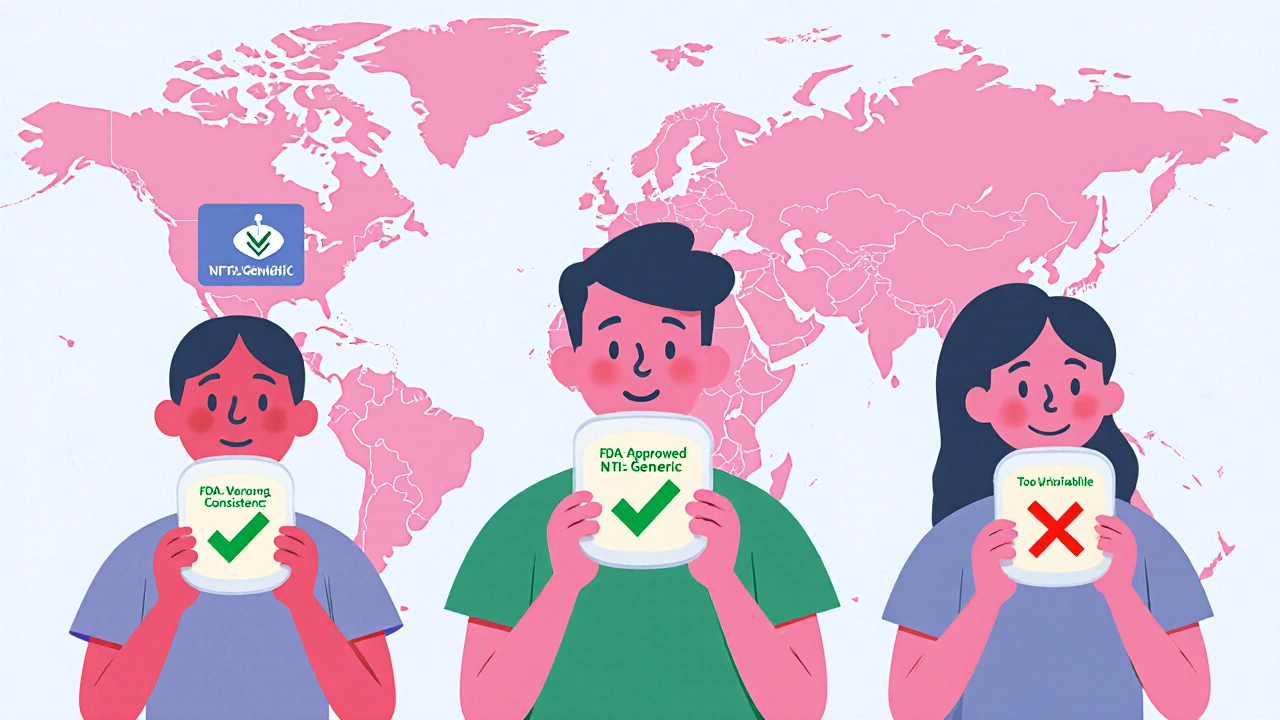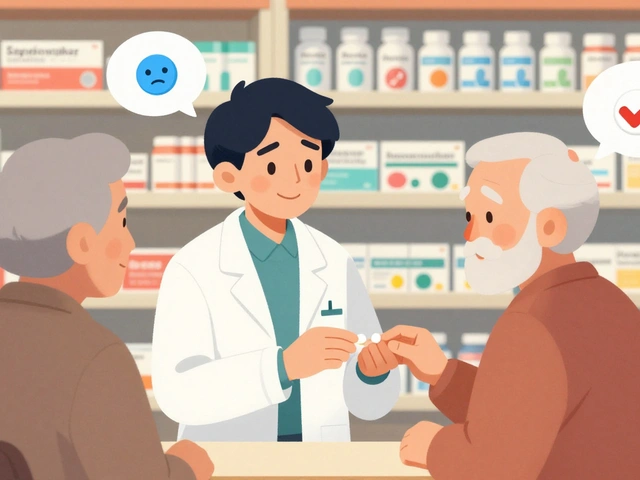FDA Bioequivalence Standards for NTI Drugs: What You Need to Know

Why NTI Drugs Need Stricter Rules
Not all generic drugs are created equal. When it comes to NTI drugs-narrow therapeutic index medications-even tiny differences in how much of the drug enters your bloodstream can mean the difference between effective treatment and dangerous side effects. These are drugs where the line between a safe dose and a toxic one is razor-thin. The FDA treats them differently because the stakes are higher. A 20% change in blood concentration might be harmless with an antibiotic, but with an NTI drug like warfarin or phenytoin, it could trigger a seizure, a blood clot, or organ rejection.
The FDA defines NTI drugs using a clear metric: if the ratio between the minimum toxic dose and the minimum effective dose is 3 or less, it’s classified as narrow therapeutic index. That’s not a guess. It’s based on data from 13 drugs analyzed in 2022, where 10 fell at or below that threshold. Drugs like digoxin, lithium, carbamazepine, and tacrolimus all meet this standard. These aren’t obscure medications-they’re critical for transplant patients, people with epilepsy, and those managing heart conditions or mood disorders.
How Bioequivalence for NTI Drugs Is Different
For most generic drugs, the FDA accepts bioequivalence if the generic delivers between 80% and 125% of the brand-name drug’s concentration in the blood. That’s a 45% window. For NTI drugs, that window shrinks to 90% to 111%. That’s less than half the range. Why? Because with these drugs, even a 10% difference can matter.
The FDA doesn’t just tighten the numbers. It uses a smarter system called Reference-Scaled Average Bioequivalence (RSABE). This method looks at how much the original brand-name drug varies from person to person. If the brand itself has high variability, the generic is allowed slightly more wiggle room-but only if it matches the brand’s pattern. For NTI drugs, though, the rules are stricter. Even if the brand is variable, the generic must still stay within the 90-111% range and also meet the old 80-125% test. It’s a double check.
There’s another layer: the within-subject variability ratio. The FDA requires that the variability of the generic drug can’t be more than 2.5 times that of the brand. This ensures the generic doesn’t just match the average dose-it matches the consistency too. A drug that works fine for one person but spikes dangerously for another isn’t acceptable, even if the average looks good.
Quality Control Is Tighter Too
Bioequivalence isn’t just about what’s in the blood-it’s about what’s in the pill. For NTI drugs, the FDA demands tighter control over manufacturing. The active ingredient in a generic NTI drug must be within 95% to 105% of the brand’s strength. For non-NTI generics, the range is 90% to 110%. That 5% tighter band might sound small, but for a drug like lithium, where a 0.2 mEq/L change can turn a therapeutic dose into a toxic one, it’s everything.
This level of precision isn’t easy. It requires advanced manufacturing, rigorous testing, and consistent raw materials. That’s why only a few manufacturers can produce NTI generics. It’s not that others can’t-they just can’t meet the FDA’s standards without major changes to their processes.

Study Designs Are More Complex
Testing bioequivalence for NTI drugs isn’t a simple two-period crossover study. The FDA requires replicate designs, meaning each participant takes both the brand and generic versions multiple times-often three or four times each. This gives researchers enough data to accurately measure within-subject variability, which is the key to the RSABE model.
These studies need more participants, more blood draws, and more statistical power. A typical bioequivalence study for a regular drug might involve 24-30 people. For NTI drugs, it’s often 40 or more. That increases cost and complexity, which is one reason why fewer generic versions exist for these drugs.
And even then, results can be tricky. One study found two generics that each met FDA standards for bioequivalence to the brand-but they weren’t bioequivalent to each other. That’s why the FDA doesn’t assume all NTI generics are interchangeable. Each one is evaluated on its own merits.
Which Drugs Are Classified as NTI?
The FDA doesn’t publish a single list of NTI drugs. Instead, it identifies them case by case through product-specific guidance documents. That means if you’re looking for a generic version of a drug, you have to check the FDA’s guidance for that specific medication.
Common NTI drugs include:
- Carbamazepine (Tegretol)
- Phenytoin (Dilantin)
- Warfarin (Coumadin)
- Digoxin (Lanoxin)
- Valproic acid (Depakote)
- Cyclosporine (Neoral, Sandimmune)
- Sirolimus (Rapamune)
- Everolimus (Zortress)
- Lithium carbonate
These drugs cover a wide range of uses: epilepsy, heart rhythm control, blood thinning, immune suppression, and mood stabilization. They’re often lifelong medications, which makes consistency even more critical.

Why This Matters to Patients
Patients taking NTI drugs need to know their generic isn’t just a cheaper version-it’s a version that had to clear a much higher bar. The FDA says these generics are safe and effective. Real-world data from transplant centers and epilepsy clinics support that: patients switched to FDA-approved NTI generics rarely experience issues.
But confusion still exists. Some doctors and pharmacists hesitate to substitute, even when the FDA approves it. That’s partly because of old fears and partly because of conflicting reports in medical literature. In some states, laws require patient consent before switching an NTI drug. Others ban substitution entirely. The FDA’s position is clear: if it’s approved, it’s interchangeable. But changing practice takes time.
For patients, the message is simple: if your generic NTI drug was approved by the FDA under the stricter standards, you can trust it. But always monitor your symptoms and report any changes to your doctor. Regular blood tests-like INR for warfarin or lithium levels-are still essential. The generic doesn’t eliminate the need for monitoring; it just makes the drug more predictable.
Global Differences in Standards
The U.S. isn’t alone in worrying about NTI drugs, but it’s one of the few that uses a scaled approach. Health Canada and the European Medicines Agency (EMA) mostly just tighten the bioequivalence limits to 90-111% without adjusting for variability. The FDA’s method is more sophisticated, but also more complex. That creates challenges when drugs are manufactured in one country and sold in another.
Some NTI generics approved in Europe may not meet U.S. standards, and vice versa. That’s why a patient traveling abroad might be advised to stick with their brand-name drug-even if a generic is available at home. The FDA is pushing for global harmonization, but progress is slow.
The Future of NTI Drug Regulation
The FDA is continuing to refine how it identifies and regulates NTI drugs. The 2022 pharmacometric model that set the therapeutic index ≤ 3 as the benchmark was a major step toward objectivity. Before that, classification was sometimes based on expert opinion or historical precedent.
Now, the agency is working on expanding the evidence base. Studies are underway to better understand interchangeability between different generic versions of the same NTI drug. There’s also growing interest in using real-world data-like electronic health records and pharmacy claims-to track outcomes after substitution.
One thing is certain: as more NTI drugs go generic, the pressure to get this right will only grow. The FDA’s standards are strict, but they’re not arbitrary. They’re based on data, science, and decades of clinical experience. For patients, that means safer, more reliable treatment. For manufacturers, it means higher costs and tougher hurdles. But for public health, it’s the only way to ensure that a life-saving drug doesn’t become a life-threatening one.
5 Comments
Archana Jha
soooooo... the FDA says its all good but did anyone else notice how many of these "NTI" drugs are also the ones big pharma used to charge $500 a pill for? now they're "safe generics" but the original makers still own the patents on the delivery systems... i mean, lithium? really? we're trusting a pill made in a factory in bangalore to have the same crystal structure as the one my neurologist prescribed in 2012? 🤔 #conspiracybutalsokindamakingSense
Aki Jones
The FDA’s RSABE model is statistically sophisticated-yes-but it’s also a regulatory sleight of hand. They tighten the bioequivalence window to 90–111%, then invoke within-subject variability ratios, then demand replicate designs... all while ignoring that pharmacokinetic variability is often driven by gut microbiome differences, epigenetic expression, and metabolic polymorphisms that aren’t even measured in these trials. And yet-somehow-we’re supposed to believe that a 40-person crossover study in healthy volunteers is predictive of long-term outcomes in elderly transplant recipients on polypharmacy? The data is cherry-picked. The science is performative. And the patients? They’re the control group.
Erika Hunt
I appreciate the depth here, and I think it’s important to remember that while the standards are strict, they’re not arbitrary-they’re grounded in real clinical consequences. I’ve worked in neurology for over 15 years, and I’ve seen patients stabilized on brand-name carbamazepine for years, then switched to a generic that wasn’t FDA-approved under NTI rules, and suddenly they were having breakthrough seizures. It’s terrifying. The FDA’s approach, even if complex, is trying to prevent that. That said, I do wish there was more transparency around which specific generics are approved for each drug-patients shouldn’t have to dig through product-specific guidance documents to know if their pill is truly interchangeable.
Pallab Dasgupta
YOOOOOOO I JUST GOT MY LITHIUM PRESCRIPTION RENEWED AND I WAS PANICKING BECAUSE THE PHARMACY SWITCHED IT TO A GENERIC-BUT THEN I CHECKED THE FDA LIST AND IT WAS ON THERE! LIKE BRO. THIS IS LIFE OR DEATH. I’M NOT JUST TAKING A VITAMIN HERE. I’M TAKING A DRUG THAT CAN TURN ME INTO A ZOMBIE OR A HUMAN BOMB IF THE DOSE IS OFF BY 0.1. AND THE FACT THAT THEY’RE MAKING THESE GENERICS MEET THE SAME INSANE STANDARDS AS THE BRAND? THAT’S A WIN. SHOUTOUT TO THE LAB TECHS WHO ARE TESTING THESE PILLS LIKE THEY’RE DETONATING NUCLEAR BOMBS. WE NEED MORE OF THIS. #NTIDrugsAreNotToys
fiona collins
Trust the science. But always monitor.






Write a comment